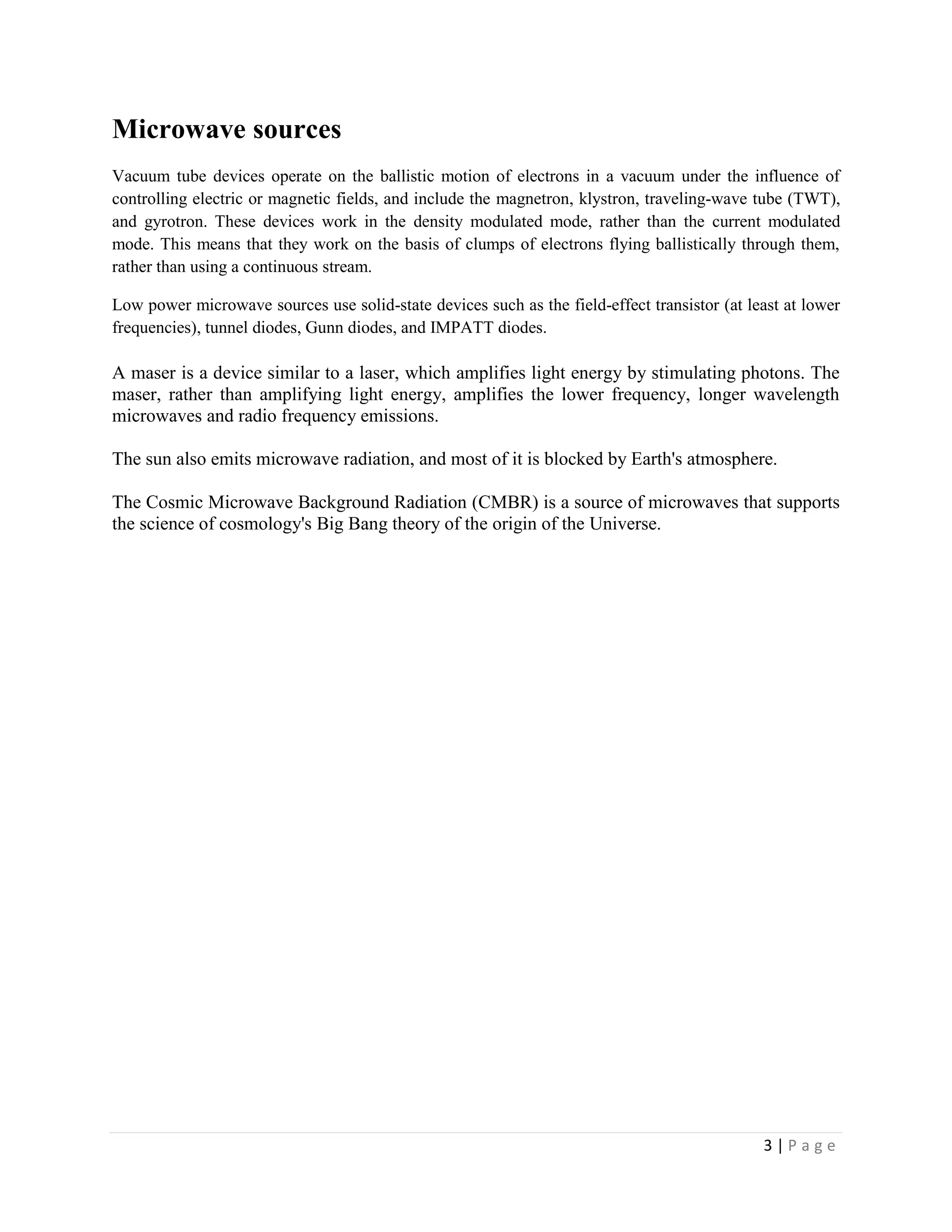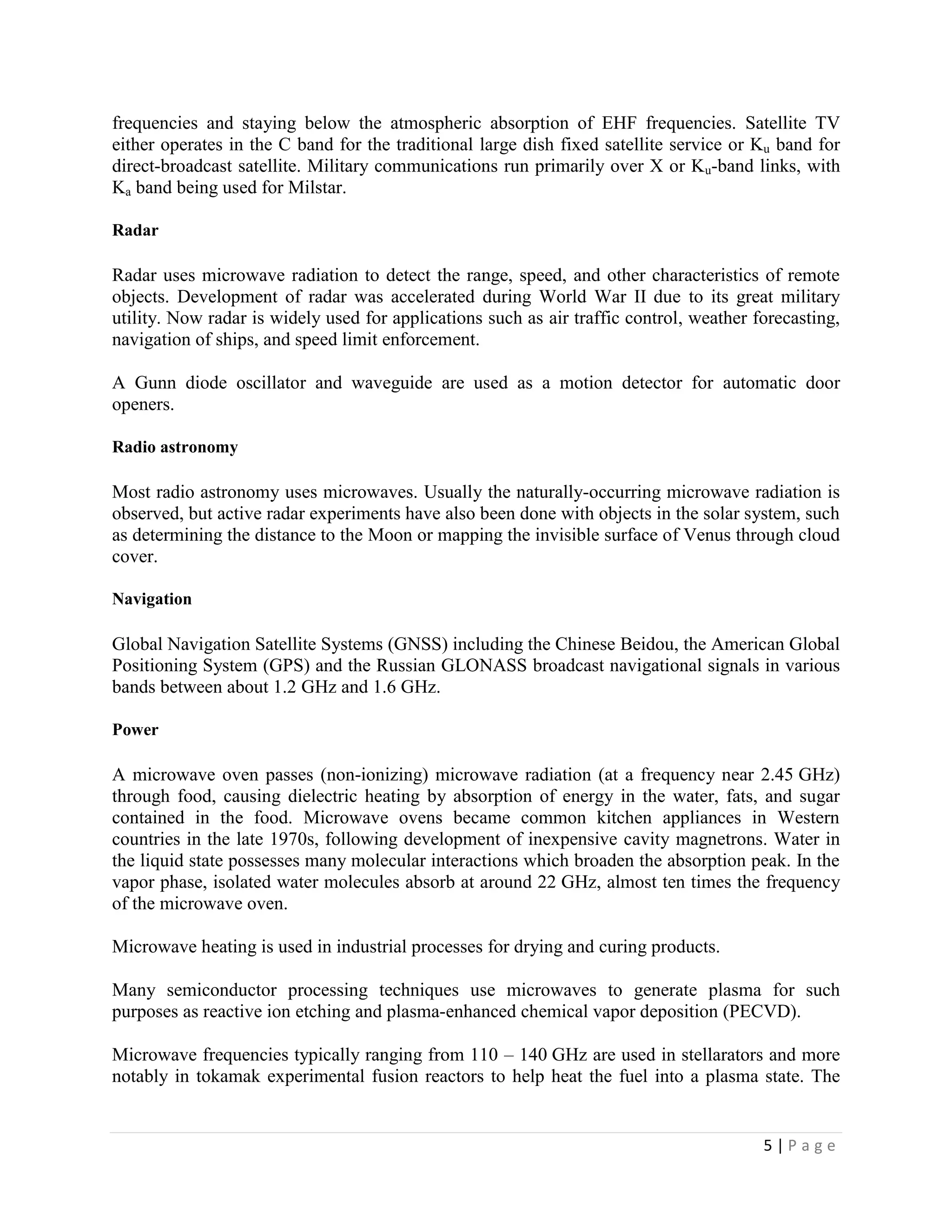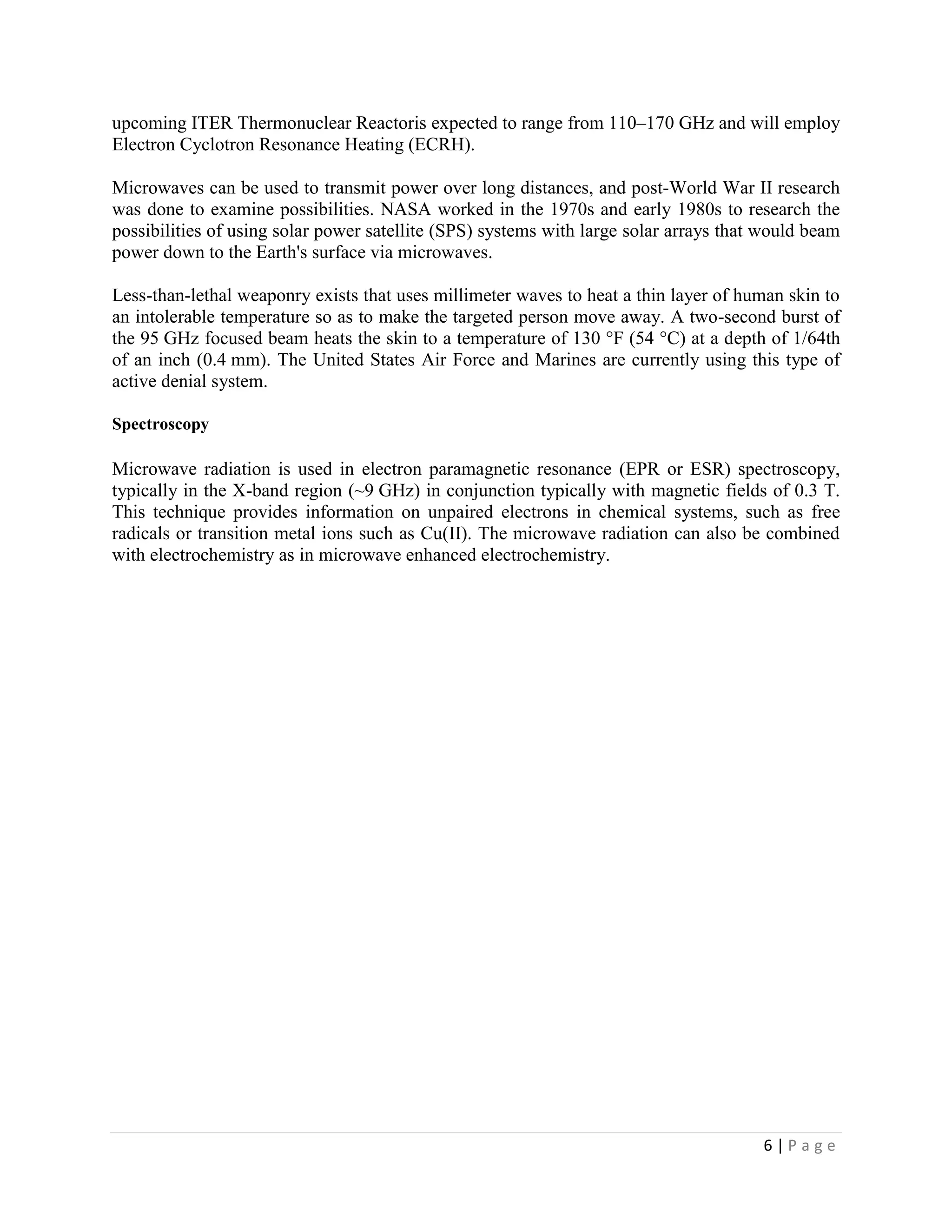The document is an assignment on microwave technology from National College of Science and Technology. It provides definitions of microwaves, describes their properties and how they differ from radio waves. It then discusses various sources of microwaves including vacuum tubes, solid state devices, and natural sources. Finally, it outlines several major uses of microwaves including communication, broadcasting, radar, navigation, heating and industrial processing.



![Uses
Communication
Before the advent of fiber-optic transmission, most long distance telephone calls were carried via
networks of microwave radio relay links run by carriers such as AT&T Long Lines. Starting in
the early 1950s, frequency division multiplex was used to send up to 5,400 telephone channels
on each microwave radio channel, with as many as ten radio channels combined into one antenna
for the hop to the next site, up to 70 km away.
Wireless LAN protocols, such as Bluetooth and the IEEE 802.11 specifications, also use
microwaves in the 2.4 GHz ISM band, although 802.11a uses ISM band and U-NII frequencies
in the 5 GHz range. Licensed long-range (up to about 25 km) Wireless Internet Access services
have been used for almost a decade in many countries in the 3.5–4.0 GHz range. The FCC
recently[when?] carved out spectrum for carriers that wish to offer services in this range in the U.S.
— with emphasis on 3.65 GHz. Dozens of service providers across the country are securing or
have already received licenses from the FCC to operate in this band. The WIMAX service
offerings that can be carried on the 3.65 GHz band will give business customers another option
for connectivity.
Metropolitan area network (MAN) protocols, such as WiMAX (Worldwide Interoperability for
Microwave Access) are based on standards such as IEEE 802.16, designed to operate between 2
to 11 GHz. Commercial implementations are in the 2.3 GHz, 2.5 GHz, 3.5 GHz and 5.8 GHz
ranges.
Mobile Broadband Wireless Access (MBWA) protocols based on standards specifications such
as IEEE 802.20 or ATIS/ANSI HC-SDMA (such as iBurst) operate between 1.6 and 2.3 GHz to
give mobility and in-building penetration characteristics similar to mobile phones but with vastly
greater spectral efficiency.[5]
Some mobile phone networks, like GSM, use the low-microwave/high-UHF frequencies around
1.8 and 1.9 GHz in the Americas and elsewhere, respectively. DVB-SH and S-DMB use 1.452 to
1.492 GHz, while proprietary/incompatible satellite radio in the U.S. uses around 2.3 GHz for
DARS.
Microwave radio is used in broadcasting and telecommunication transmissions because, due to
their short wavelength, highly directional antennas are smaller and therefore more practical than
they would be at longer wavelengths (lower frequencies). There is also more bandwidth in the
microwave spectrum than in the rest of the radio spectrum; the usable bandwidth below
300 MHz is less than 300 MHz while many GHz can be used above 300 MHz. Typically,
microwaves are used in television news to transmit a signal from a remote location to a television
station from a specially equipped van. See broadcast auxiliary service (BAS), remote pickup unit
(RPU), and studio/transmitter link (STL).
Most satellite communications systems operate in the C, X, Ka, or Ku bands of the microwave
spectrum. These frequencies allow large bandwidth while avoiding the crowded UHF
4|Page](https://image.slidesharecdn.com/microwavecharles-120114184629-phpapp02/75/Microwave-charles-4-2048.jpg)



![History and research
The existence of electromagnetic waves was predicted by James Clerk Maxwell in 1864 from his
equations. In 1888, Heinrich Hertz was the first to demonstrate the existence of electromagnetic
waves by building an apparatus that produced and detected microwaves in the UHF region. The
design necessarily used horse-and-buggy materials, including a horse trough, a wrought iron
point spark, Leyden jars, and a length of zinc gutter whose parabolic cross-section worked as a
reflection antenna. In 1894 J. C. Bose publicly demonstrated radio control of a bell using
millimeter wavelengths, and conducted research into the propagation of microwaves.[12]
Perhaps the first, documented, formal use of the term microwave occurred in 1931:
"When trials with wavelengths as low as 18 cm were made known, there was undisguised
surprise that the problem of the micro-wave had been solved so soon." Telegraph &
Telephone Journal XVII. 179/1
In 1943: the Hungarian engineer Zoltán Bay sent ultra-short radio waves to the moon, which,
reflected from there worked as a radar, and could be used to measure distance, as well as to study
the moon.[13]
Perhaps the first use of the word microwave in an astronomical context occurred in 1946 in an
article "Microwave Radiation from the Sun and Moon" by Robert Dicke and Robert Beringer.
This same article also made a showing in the New York Times issued in 1951.
In the history of electromagnetic theory, significant work specifically in the area of microwaves
and their applications was carried out by researchers including:
Specific work on microwaves
Work carried out by Area of work
Barkhausen and Kurz Positive grid oscillators
Hull Smooth bore magnetron
Varian Brothers Velocity modulated electron beam → klystron tube
Randall and Boot Cavity magnetron
8|Page](https://image.slidesharecdn.com/microwavecharles-120114184629-phpapp02/75/Microwave-charles-8-2048.jpg)